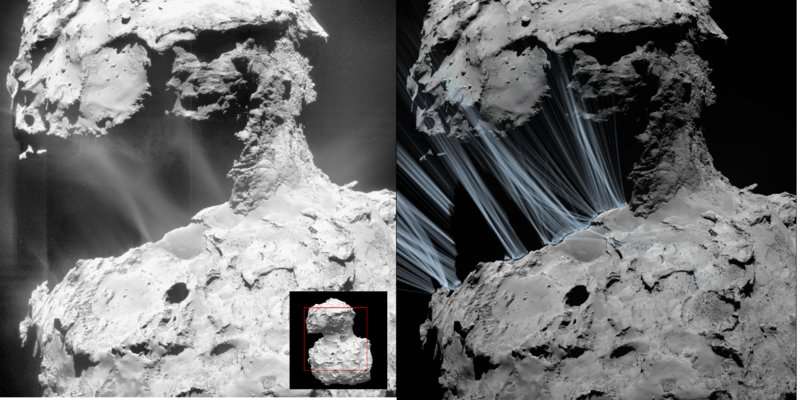Rosetta unravels formation of sunrise jets

The atmosphere of Rosetta's comet 67P/Churyumov-Gerasimenko is far from homogeneous. In addition to sudden outbursts of gas and dust, daily recurring phenomena at sunrise can be observed. In these, evaporating gas and entrained dust are concentrated to form jet-like structures. A new study, led by the Max Planck Institute for Solar System Research (MPS) in Germany and published in the journal Nature Astronomy, now identifies the rugged, duck-shaped structure of the comet as the main cause of these jets. Not only do concave regions collimate gas and dust emissions similar to an optical lens, the complex topography also provide some areas of the surface with more sunlight than others.
Far from the Sun, comets are lifeless, ice-cold bodies. When they progress into the inner solar system, they become active: frozen gases such as water evaporate and entrain dust particles from the surface. In this way the coma, a shroud of gas and dust, is formed. Already in images from earlier cometary missions such as Giotto, which flew by comet 1P/Halley in 1986, distinct jets of gas and dust were visible within the coma. They reach up to several kilometers into space. For scientists, these jets are the key to cometary activity. When and where do they occur? Which processes on the surface are involved? And what do they reveal about the nature and composition of the comet?
No mission has been able to pursue these questions in as great detail as ESA's Rosetta mission. From August 2014 to September 2016, the Rosetta spacecraft orbited comet 67P/Churyumov-Gerasimenko witnessing its transformation from an almost lifeless to a gas- and dust-spewing body from close-up. More than 70 000 images taken by the scientific camera system OSIRIS, which was developed and built under the leadership of MPS, document this process. They contain both eruptive, sudden outbursts of gas and dust, as well as jets that are stable for a longer time. In their most recent publication, researchers from the OSIRIS team have now investigated the activity that occurs regularly every morning.
"When the Sun rises over a part of the comet, the surface along the terminator almost instantaneously becomes active," first author Dr. Xian Shi from MPS describes. "The jets of gas and dust, which we then observe within the coma, are very reliable: they are found each morning in the same places and in a similar form," she adds. Responsible for this early morning activity is the frost, which forms at night on the cold comet surface. As soon as the Sun's rays touch it, it begins to evaporate.
"Outbursts can often be traced back to a small area on the surface where suddenly frozen water is exposed, for example due to a landslide," explains Dr. Holger Sierks from the MPS, OSIRIS Principal Investigator. "In the case of cometary activity at sunrise, this is different. The frost is distributed fairly evenly over the entire surface." But then why do the gas and dust emissions form jets? Why do they not create a completely homogeneous cloud?
The new study shows for the first time that mainly the unusual shape and jagged topography of the comet are responsible for this phenomenon. The researchers analyzed images at different observation geometries of the Hapi region located on the "neck" of the comet, the narrow part connecting its two lobes. In computer simulations, they were able to reproduce these images thus gaining a better understanding of the driving processes.
In particular, two effects proved to be decisive. Some regions on the surface are located at lower altitudes or in the shade. The first rays of sunlight reach them later. In contrast, the frost evaporates particularly efficiently from the early and strongly illuminated regions. In addition, pits and other concave structures virtually concentrate gas and dust emissions - much like an optical lens.
"The complex shape of Rosetta's comet makes many investigations difficult. But for this study it was a blessing", says Shi. On a spherical or even potato-shaped comet, these structures within the coma might not be as prominent. Gas and dust would be much more evenly distributed.
In addition, the new study investigates the influence of the observation geometry. "Basically, every cometary coma is a three-dimensional structure, and each shot of it is just a projection," Sierks says. "Our images can therefore easily give a false impression." The daily recurring jets are particularly well suited to analyzing this effect, as Rosetta orbited the comet for a long time, looking at the sunrise over a particular region several times from different angles.
Rosetta is a space mission of the European Space Agency (ESA), which reached its destination, comet 67P/Churyumov-Gerasimenko, in August 2014 and orbited it for more than two years. In November 2014 Rosetta deployed a lander on the comet. The Max Planck Institute for Solar System Research is the research institution worldwide with the strongest participation in the mission. Among other things, the institute leads the OSIRIS and COSIMA teams.
More information: X. Shi et al. Coma morphology of comet 67P controlled by insolation over irregular nucleus, Nature Astronomy (2018). DOI: 10.1038/s41550-018-0481-5
Journal information: Nature Astronomy




















